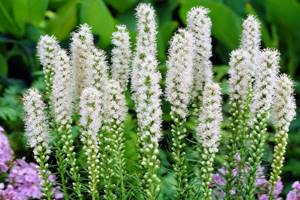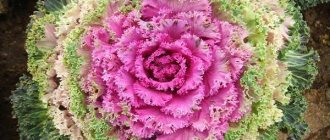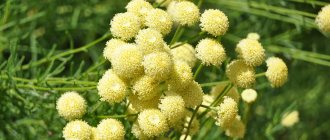Description of the plant
Liatris (also called Deertongue) are found naturally in North America. The plants have been grown in gardens since the 18th century. Liatris belongs to the Asteraceae family and is a flowering plant. The bushes form a rosette of leaves, from which hard shoots with inflorescences grow, reaching 60-100 cm in height.
Liatris leaves are dark green and form dense, herbaceous clumps. The individual leaves are narrow and are a characteristic feature of this perennial. It is worth noting that liatris flowers are not an evergreen plant, but are popular in gardens.

Their main decoration is flowers, forming dense spikes 15-30 cm long, blooming from top to bottom.

It is thanks to the flowers that gardeners grow Deer Tongue in their gardens. Liatris blooms from July to October, depending on the type and variety. Flowers come in different colors:
- blue-red,
- pink,
- purple,
- whitish.

They are beautiful and honey-bearing, attract butterflies, bees, and bumblebees. Variations of this perennial plant usually vary in flower color. Small flowers form inflorescences-baskets. The baskets are collected in long and cylindrical ears, reaching 15-30 cm in length. Tubular flowers stand out in baskets. A characteristic feature of the perennial is the order in which the baskets develop: the baskets at the top of the shoot bloom first and sequentially fall down. Liatris blooms from July to October. Old inflorescences curl, making them unsightly.
Photo. Inflorescences before flowering and begin to bloom from above

The underground part of the plant is the tubers. They store water and nutrients. Liatris is propagated using tubers.
Landing
Three main varieties of liatris can be purchased in the store - spikelet, filmy and rough. Each has its own characteristics, but also has a lot in common.

In order to grow a beautiful plant, any option, first of all, you need to choose a place. Liatris likes:
- sun, to a lesser extent partial shade;
- areas are well-dried, without close groundwater;
- fertile soil with a high humus content, easily allowing moisture to pass to the lower layers.

It is a perennial plant, forms within two years, and begins to bloom in the third year. It can grow up to two meters in height, but for this you need to try.

Types and varieties
The genus Liatris includes 50 species. There are 2 types in cultivation:
- bushy liatris (Liatris pycnotachya) - grows up to 100 cm, has long narrow leaves and dark pink flowers;

- liatris spicata (liicris spicata) - more common in our gardens, grows up to 50 cm, the leaves are shorter and wider than those of the bushy liatris, and the flowers are purple.

The most famous varieties
| Name and description of the variety | Photo |
| Kobold - with purple flowers, compact, grows up to 30-50 cm in height. Used on rocky and perennial ridges. Flowering: June-October. |
|
| Floristan violet – with light purple flowers, up to 100 cm |
|
| Floristan White – with white flowers |
|
| Floristan weiss - with white flowers, up to 100 cm high |
|
| Alba (Alba) – white inflorescences, height 60-100 cm. |
|
| Callilepis - dark, purple-pink flowers, about 80-90 cm high. |
|
Diseases and pests

Liatris Alba
Planting and growing a plant will not require much effort from you. The plant has not only good ease of care, but also good immunity against many diseases. The greatest danger is the attack of snails and mole crickets. To get rid of such uninvited guests, you can use one good folk method. You should add 0.5 cups of beer to the bottle, after which you dig this bottle into the ground at an angle of 45 degrees, watch the location of the neck - it should be located 20-30 mm lower than the soil surface, in a small hole. Feeling the aroma of this drink, snails and mole crickets will be trapped in your place. However, remember that to achieve the desired effect you will have to systematically change the beer. If there is stagnation of moisture in the soil, then the appearance of rot can be observed. To get rid of it, all damaged areas of the plant need to be cut off, and only then begin treatment with fungicides. If the cause of rotting is excessive soil heaviness or there is groundwater nearby, then it is better to think about changing the place for growing the plant.
Growing in open ground
Many people wonder how to plant and grow liatris so that the perennial will delight you with flowers longer. It’s not difficult, liatris is a low-demanding, frost-resistant plant. It's worth knowing a little basic information about care and the type of soil that suits it. This is a great solution for flower lovers who know little about gardening.
To flower, the bushes require a long 14-hour daylight hours. There is no need to overcool plants to form flowers, however, exposure to temperatures of about 5 ° C for 10-12 weeks has a beneficial effect on the quality and abundance of flowering.
Soil requirements
Liatris grows well in any soil, but fresh, fertile and permeable soil, with a slightly acidic pH of 6.0-6.5, is desirable.
This plant loves the sun! The position should be sunny (minimum 6 hours of sunlight). Liatris also grows on sandy and dry soils, in semi-shaded places, and blooms weaker. On sandy soil the plant grows noticeably less and the inflorescences are shorter. But it blooms just as beautifully, no less profusely, it’s just that the stems are shorter.
The perennial does not like heavy and marshy soils - due to subsequent rot of the tubers.
When planting in pots, the soil can be prepared. The substrate can be peat with the addition of clay (15-30%) and a loosening material, such as perlite, sand or composted pine bark (0-20%).

Reproduction and planting
The liatris plant can be propagated by seeds and by dividing the tubers.
Sowing and growing from seeds
Liatris can be propagated from seeds that the plant produces abundantly. Before sowing, seeds can be exposed to low temperatures (called stratification) to allow them to germinate. However, this is not a mandatory measure. Stratification is more necessary for seeds collected in summer and sown in spring. If the liatris itself sows the seeds, they overwinter in the soil and germinate well in the spring.
Photo. Dried inflorescence with seeds.

In spring (March-April), the seeds are sown finely, directly into the ground. The seedlings rise very beautifully, evenly, without requiring shelter.

The sprouts grow very slowly, flowering will begin only after 3-4 years.

Plants can also be pre-planted in pots. Sowing date: January-March. 1 g contains about 300 seeds. To produce 1000 plants, 10 g of seeds should be sown. It is better to place the seeds in multi-tiered trays, covering them with a thin layer of vermiculite (for germination), which provides sufficient moisture.

The substrate temperature during the germination period should be 18-21 °C. By lowering the temperature at night to 6 °C, seed germination can be accelerated. Shoots will appear in 2-3 weeks. After this period, the temperature should be gradually reduced to 16-18 °C. After another 4 weeks, the seedlings are planted in larger trays; after another 6-8 weeks they can be planted in pots.
Dividing the bush
Every 3 years, liatris begins to bloom worse, it’s good to separate them and replant. They grow quickly, creating beautiful bushes.
If you want to cultivate Liatris varieties, it is safe to propagate them by dividing the tuberous roots. This ensures that the resulting seedlings will have similar decorative properties as the mother plant and will bloom much faster than seedlings propagated from seeds.
The tubers are divided in the spring from March to May. Each seedling should have a tuber with several healthy buds. Initially, the plant can be grown in pots; it should be replanted in open ground in April.
In autumn you can clearly see the bulging red eyes, so it is easy to determine what to separate. Liatris can be divided in 2 ways:
- separate individual bulbs - this way we will get more new plants that will last longer without dividing, but it will take time before a decent bush grows;
- divide the entire rhizome with a shovel - we leave several bulbs on the divided piece, so we will get the effect faster.

Larger rhizomes are better able to withstand attacks from voles. Liatrises planted in small, homogeneous groups look impressive.
When choosing a method of division, it is worth knowing that when dividing the entire cluster of tubers into parts, individual bulbs will necessarily disappear and can be planted separately.
Landing
Tuber planting scheme: tubers are planted to a depth of 10-12 cm with an interval of about 20 cm.
In spring you can buy individual tubers in garden stores and supermarkets. The tubers are not too susceptible to drying out, so they will definitely sprout and, most likely, bloom this year. Provided they are not from last year.
Important! Only tubers from the current year are suitable for planting. They may bloom later this year.
When planting in pots, their size is selected as follows:
- individually in pots with a diameter of 12-15 cm;
- 2-3 samples in 3-5 liter pots.
Care in summer, autumn, wintering
Apart from watering, no special care is needed. Faded inflorescences, if you do not plan to collect seeds, need to be cut off. Stems are pruned in the fall for better growth and compaction. They should be cut to a height of 10 cm.

The perennial overwinters in the ground; it is completely frost-resistant, although in snowless, cold winters it is better to cover it with leaves or compost.
From the end of September, the plants are transferred to a rest period.
Photo. Liatris in winter

Pests and diseases
Liatris needs to be protected from rodents that eat its tuberous roots, so it is worth planting the plants in special baskets.
The plant's biggest enemy is voles.
Sometimes liatris become infected with fungal diseases. When these are individual plants carelessly scattered around the garden, diseases do not occur often. Old accumulations are too compacted - they are more susceptible to fungi. Therefore, it is worth dividing the liatris every few years. Moreover, in older bushes the inflorescences do not stand perfectly vertically, but bend outward. This shape does not add charm.
Too dense and wet soil can cause tuber rot.
Sometimes the perennial is affected by powdery mildew. In spring, plants can be attacked by snails.
Growing and propagating liatris flowers
Liatris flowers can appear from corms, rhizomes or elongated root crowns. You can buy them at nurseries or specialized garden stores, where you can’t live without them.
Growing a liatris flower begins with the selection and preparation of high-quality planting material.
The advantage of this plant is that they begin to bloom in the year of planting, that is, you do not have to wait long and painfully for several years until the flowers fully ripen and produce high-quality seeds, beautiful and bright flowers, as well as healthy, shiny foliage.

You can also easily grow liatris yourself from seeds. To start, place them indoors or directly sow them in the garden in early spring.
It usually takes two weeks to a month and a half for the seeds to germinate.
You can improve their germination yourself if you store the seeds for 1-1.5 months in a damp and cool place. Gardeners often achieve a similar effect by planting them outdoors in the fall or early winter.
Typically, plants grown from seed do not flower until they are two years old. Reproduction of liatris flowers by seed does not always guarantee the preservation of genetic characteristics, this is especially pronounced when growing hybrids.
The division of tubers is carried out when the plant is already quite mature and the roots have become very large - the procedure is carried out in the spring, when the first leaves appear.
Individual corms or tuberous roots are cut using a sharp knife or scissors (sometimes a shovel is used), reserving at least one soil for each removed shoot.
Application in landscape design
Liatris will decorate gardens in an attractive way and give them amazing grace. Liatris looks good in garden beds, naturalistic and exotic plantings (due to their interesting shape). Low varieties can be grown in containers and rock gardens. This is a great flower to plant next to brick walls. The flowers look great in bouquets and vases (they do not wither for 2 weeks), and are used in floristry - for dry bouquets.
In perennial flower beds, liatris will form a distinct vertical accent. It does not take up much space, making it suitable for small gardens. In the composition it looks beautiful in the company of rose hips, lavender, roses, bells, Patagonian verbena, and herbs. Looks great in close proximity to flowering perennials and plants with decorative leaves - wormwood, daylilies, phlox.
Liatris makes a great cut flower. Its tough and simple inflorescences are cut off when the first flowers begin to grow. The vase has a shelf life of up to two weeks. Dried inflorescences can be used for dry bouquets.
Due to the attractiveness of the inflorescence, wide range of uses and modest requirements, it is sure to find many lovers. This exotic perennial will bring cheerful color and vertical accent in late summer when there are very few showy perennials.
In addition to its undeniable decorative qualities, liatris is a honey plant. Bees, bumblebees and butterflies visit it very willingly. If we want to have a garden full of humming life, we need to plant honey plants.

Using liatris in garden decoration
Liatris is quite often used in garden landscape design. This popularity is explained not only by long flowering, but also by the unpretentiousness of the culture. Thus, the plant can be used for planting in areas with rocky, infertile soil, where other flowering crops cannot be grown (Figure 3).

Figure 3. Using a plant to decorate a garden
In addition, liatris is often used to create flower arrangements. It goes well with phlox, verbena and gypsophila.

















